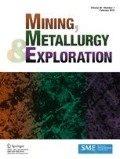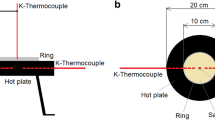Abstract
Mine equipment fires remain as one of the most concerning safety issues in the mining industry, and most equipment fires were caused by hot surface ignitions. Detailed experimental investigations were conducted at the NIOSH Pittsburgh Mining Research Division on hot surface ignition of liquid fuels under ventilation in a mining environment. Three types of metal surface materials (stainless steel, cast iron, carbon steel), three types of liquids (diesel fuel, hydraulic fluid, engine oil), four air ventilation speeds (0, 0.5, 1.5, 3 m/s) were used to study the hot surface ignition probability under these conditions. Visual observation and thermocouples attached on the metal surface were used to indicate the hot surface ignition from the measured temperatures. Results show that the type of metal has a noticeable effect on the hot surface ignition, while ventilation speed has a mixed influence on ignition. Different types of liquid fuels also show different ranges of ignition temperatures. Results from this work can be used to help understand equipment mine fires and develop mitigation strategies.








Similar content being viewed by others
References
MSHA (2018) Accident data file downloads. United States Department of Labor, Mine Safety and Health Administration.https://arlweb.msha.gov/OpenGovernmentData/OGIMSHA.asp
DeRosa MI (2004) Analysis of mine fires for all U.S. metal/nonmetal mining categories, 1990–2001. Pittsburgh: U.S. Department of Health and Human Services, Centers for Disease Control and Prevention, National Institute for Occupational Safety and Health, DHHS (NIOSH) Publication No. 2005–105, Information Circular 9476; 1–52
Hansen R (2009). Literature survey–Fire and smoke spread in underground mines. Mälardalens Högskola, MdH SiST 2. Västerås
ASTM E-659 (2015) Standard test method for auto ignition temperature of chemicals. ASTM, West Conshohocken
NFPA 921 (2017) Guide for Fire and Explosion Investigations. National Fire Protection Association, Quincy
Shaw A, Epling W, McKenna C, Weckman B (2010) Evaluation of the ignition of diesel fuels on hot surfaces. Fire Technol 46:407–423
Davis S, Kelly S, Somandepalli V (2010) Hot surface ignition of performance fuels. Fire Technol 46:363–374
Li YL, Wang YH, Lu SX (2010) Ignition of the leaked diesel on a heated horizontal surface. Fire Saf J 45:56–68
MSHA (n.d.) Report on minimum ventilation requirement for mine diesel engines. https://lakegovprod3.msha.gov/ReportView.aspx?ReportCategory=EngineAppNumbers. Accessed Aug 2016
Foose JG (1983) F-16 Engine nacelle fire-prevention requirements study, general dynamics report no. 16, PR2771
Johnson AM, Roth AJ, Moussa NA (1988) Hot surface ignition tests of aircraft fluids, report no. AFWAL-TR-88–2101, Wright-Patterson Air Force Base, OH
L. Parts (1979) Assessment of the flammability of aircraft hydraulic fluids, report no. AFAPL-TR-79–2055, Wright-Patterson Air Force Base, OH
Severy DM, Blaisdell DM, Kerkhoff JF (1974) Automotive collision fires. In: Proceedings of Eighteenth STAPP Car Crash Conference, Society of Automotive Engineers, Warrendale, PA, December 4–5, pp 113–199
Acknowledgements
Data from this manuscript had been presented at the 2022 SME Conference.
Author information
Authors and Affiliations
Corresponding author
Ethics declarations
Conflict of Interest
The authors declare that there is no conflict of interest.
Disclaimer
The findings and conclusions in this paper are those of the authors and do not necessarily represent the official position of the National Institute for Occupational Safety and Health, Centers for Disease Control and Prevention. Mention of any company or product does not constitute endorsement by NIOSH.
Additional information
Publisher's Note
Springer Nature remains neutral with regard to jurisdictional claims in published maps and institutional affiliations.
Rights and permissions
About this article
Cite this article
Tang, W., Bahrami, D., Yuan, L. et al. Hot Surface Ignition of Liquid Fuels Under Ventilation. Mining, Metallurgy & Exploration 39, 961–968 (2022). https://doi.org/10.1007/s42461-022-00609-w
Received:
Accepted:
Published:
Issue Date:
DOI: https://doi.org/10.1007/s42461-022-00609-w




